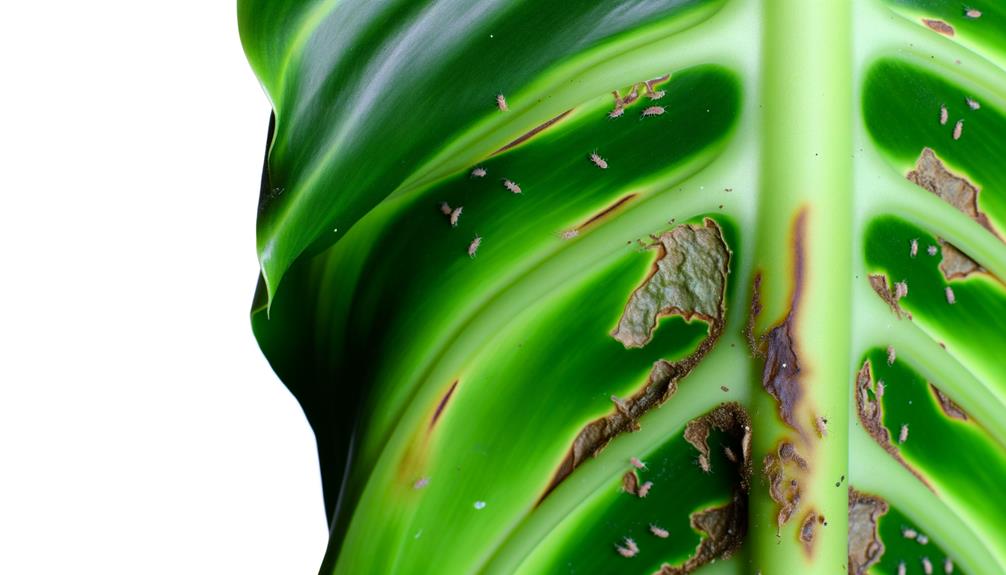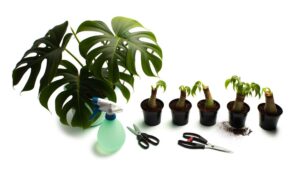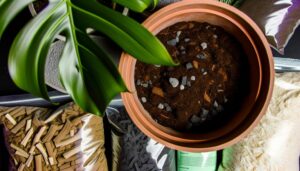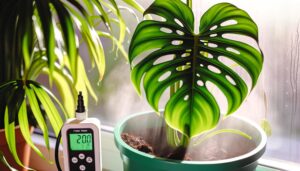Monstera Standleyana Common Pests
When caring for your Monstera Standleyana, you'll often face common pests like spider mites, mealybugs, scale insects, aphids, and thrips. Spider mites (Tetranychidae) create webbing and stipple leaves, while mealybugs appear as white, cottony masses and extract sap.
Scale insects, with their shell-like structures, disrupt photosynthesis, causing chlorosis. Aphids cluster on new growth, leading to distorted foliage, and thrips cause silvery stippling and black fecal spots on leaves.
Effective pest management includes mechanical removal, insecticidal soap, and regular monitoring. Understanding these pests guarantees a healthier Monstera Standleyana and could teach you important plant care techniques.

Key Takeaways
- Spider mites: Thrive in dry, warm conditions; identified by webbing and stippling damage on Monstera Standleyana leaves.
- Mealybugs: Appear as white, cottony masses; cause stunted growth and yellowing leaves by extracting sap.
- Scale insects: Small, immobile, shell-like structures; disrupt nutrient flow, causing chlorosis and stunted growth.
- Aphids: Small, soft-bodied insects clustering on new growth; lead to distorted foliage and stunted plant development.
- Thrips: Cause silvery stippling and black fecal spots on leaves; control with insecticidal soap or Spinosad.
Identifying Spider Mites
Spider mites, belonging to the Tetranychidae family, are tiny arachnids that can be identified by their webbing and the stippling damage they cause on Monstera standleyana leaves. You'll notice minute, pale spots on the foliage as these pests feed on the plant's chlorophyll. Their feeding punctures epidermal cells, leading to chlorotic patches.
Under a magnifying glass, you might also observe their characteristic silk webbing, which they use for protection and mobility. These mites thrive in dry, warm conditions and can rapidly proliferate, covering your Monstera in a fine, dusty web. To confirm their presence, you should check the undersides of the leaves where they typically congregate.
Early detection is vital to manage their population and prevent severe damage.
Battling Mealybugs
Shifting focus from spider mites, let's address the issue of mealybugs, another common pest that can infest your Monstera standleyana. Mealybugs (Pseudococcidae) are small, sap-sucking insects that appear as white, cottony masses on the plant. They weaken the plant by extracting sap, leading to stunted growth and yellowing leaves.
To combat these pests, follow these steps:
- Manual Removal: Use a cotton swab dipped in isopropyl alcohol to wipe off visible mealybugs.
- Neem Oil Application: Spray a diluted solution of neem oil, which acts as an insecticide and repellent.
- Systemic Insecticides: For severe infestations, use systemic insecticides containing imidacloprid, which is absorbed by the plant and targets the pests internally.
Regular monitoring will help keep your Monstera healthy.
Recognizing Scale Insects
When you inspect for scale insects, look for small, immobile, shell-like structures on stems and leaves, often resembling tiny fish scales.
These pests, belonging to the superfamily Coccoidea, disrupt photosynthesis and nutrient flow, leading to chlorosis and stunted growth.
You'll notice yellowing leaves and a sticky residue known as honeydew, which can also attract sooty mold.
Identifying Scale Characteristics
To identify scale insects on your Monstera standleyana, look for small, immobile, dome-shaped pests that adhere to the plant's stems and leaves, often appearing as tiny bumps or discolored patches. These pests are part of the superfamily Coccoidea and can be tricky to spot due to their protective waxy coverings.
Key characteristics include:
- Size and Shape: They're typically less than 5 mm in diameter, oval or round.
- Coloration: Varies from brown to tan, sometimes with a translucent or opaque appearance.
- Texture: Hard or soft scales; hard scales (Diaspididae) have a shell-like cover, while soft scales (Coccidae) produce a waxy secretion.
Understanding these traits helps you accurately identify and manage scale infestations.
Impact on Plant Health
Scale insects can significantly compromise the health of your Monstera standleyana by siphoning essential nutrients, leading to stunted growth, yellowing leaves, and increased susceptibility to other pathogens. These pests, identified as Coccoidea, attach themselves to stems and leaves, forming protective coverings. You'll notice sticky honeydew excreted by these insects, fostering sooty mold growth.
| Symptom | Description |
|---|---|
| Stunted Growth | Reduced leaf size and overall plant development |
| Yellowing Leaves | Chlorosis caused by nutrient depletion |
| Sooty Mold | Fungal growth due to honeydew secretion |
| Increased Pathogens | Weakened plant defenses, making it prone to infections |
Regularly inspect your plant, focusing on leaf undersides and stems. Early detection is vital for effective management and maintaining your Monstera's health.
Handling Aphid Infestations
Dealing with aphid infestations on Monstera standleyana involves identifying small, soft-bodied insects that cluster on new growth and undersides of leaves, often causing distorted foliage and stunted plant development.
To manage these pests, follow these steps:
- Mechanical Removal: Use a strong stream of water to dislodge aphids from the plant. This method physically removes the pests without chemicals.
- Insecticidal Soap: Apply a solution of insecticidal soap (potassium salts of fatty acids) directly to the affected areas. This dehydrates and kills aphids upon contact.
- Biological Control: Introduce natural predators like ladybugs (Coccinellidae) or lacewings (Chrysopidae) to your garden. These beneficial insects consume aphids and help maintain a balanced ecosystem.
Dealing With Thrips
You'll first need to identify a thrips infestation by observing for signs such as silvery stippling on leaves and black fecal spots.
Implement effective control methods by using insecticidal soap or Spinosad, ensuring thorough coverage of both upper and lower leaf surfaces.
Regular monitoring and prompt action are vital to prevent these pests from causing extensive damage to your Monstera Standleyana.
Identifying Thrips Infestation
Thrips infestation in Monstera standleyana can be identified by the presence of silvery or bronze streaks on the leaves, accompanied by tiny, dark fecal spots. Thrips (Order: Thysanoptera) are minute insects, often less than 1.5 mm in length, that can cause significant damage to your plant.
You'll notice the following symptoms:
- Distorted Growth: New leaves may appear deformed or curled.
- Leaf Discoloration: Faded or discolored patches might develop on the leaves.
- Visible Thrips: Use a magnifying glass to spot the slender, elongated bodies of thrips on the undersides of leaves.
Effective Control Methods
To effectively control thrips on your Monstera standleyana, start by introducing natural predators like *Amblyseius cucumeris* and *Orius insidiosus* to your plant environment. These predatory mites and bugs target thrips larvae and adults, reducing their population.
You should also employ insecticidal soaps or neem oil, which disrupt the thrips' life cycle. Make sure to apply these treatments thoroughly, covering both the upper and lower leaf surfaces.
Regularly inspect your plant, focusing on new growth where thrips tend to congregate. Additionally, maintaining a clean growing area by removing plant debris can prevent thrips from establishing a habitat.
Combining biological control, chemical treatments, and vigilant monitoring creates an integrated pest management strategy, ensuring your Monstera standleyana thrives.
Preventing Fungus Gnats
Have you considered how maintaining proper soil moisture levels can effectively prevent the proliferation of fungus gnats (Sciaridae) in your Monstera standleyana? Fungus gnats thrive in consistently damp soil, so controlling moisture is essential.
Here are three key strategies to prevent these pests:
- Watering Technique: Employ a deep, infrequent watering method to make sure the top inch of soil dries out between waterings.
- Soil Composition: Use well-draining potting mix, preferably with perlite or sand, to avoid water retention.
- Environmental Control: Ensure adequate ventilation and avoid over-crowding plants, which can trap moisture.
Conclusion
Think of your Monstera standleyana as a fortress besieged by minuscule invaders—spider mites (Tetranychus urticae), mealybugs (Pseudococcidae), scale insects (Coccidae), aphids (Aphidoidea), thrips (Thysanoptera), and fungus gnats (Bradysia spp.).
Your diligent defenses—quarantine, insecticidal solutions, and vigilant inspections—are the ramparts. Each pest requires a tailored counterattack, much like a strategic military operation.
By understanding and combating these common pests, you'll ensure your Monstera remains a flourishing, impregnable stronghold of green vitality.






